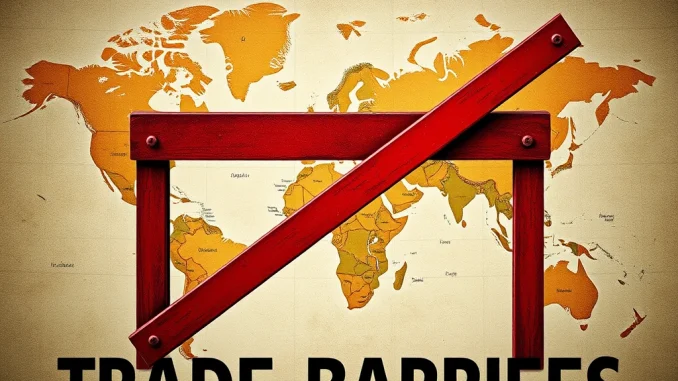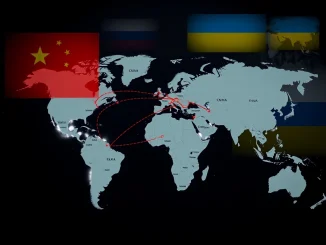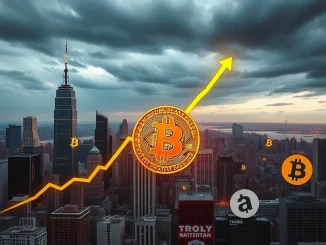
The global trade landscape is once again under scrutiny as recent statements from U.S. Commerce Secretary Howard Lutnick have cast a spotlight on the enduring nature of tariffs imposed during the Trump administration. For those keeping a close eye on economic shifts and their potential ripple effects on cryptocurrency markets, this news carries significant weight. Let’s delve into what this means and why it matters.
Unpacking the Stance on Trump Tariffs: Are They Truly Impossible to Eliminate?
Commerce Secretary Lutnick’s assertion that it’s ‘impossible’ for President Trump to eliminate Trump tariffs isn’t just a casual remark. It signals a potentially entrenched trade policy. This statement suggests a firm stance, indicating that these tariffs are not merely bargaining chips but rather a fundamental aspect of the U.S. trade strategy, at least under the Trump administration’s perspective. But what exactly does this mean in practical terms?
- Entrenched Policy: The word ‘impossible’ suggests a deep entrenchment of these tariffs within the U.S. economic framework. It moves beyond temporary measures and hints at a more permanent fixture in trade relations.
- Negotiation Leverage: Lutnick clarifies that negotiation is possible, but only if other countries address both tariff and non-tariff barriers. This frames the tariffs as leverage, pushing other nations to make concessions on a broader range of trade issues.
- Focus on Reciprocity: The condition for negotiation highlights a push for reciprocity in trade. The U.S. seems to be aiming for a level playing field where perceived imbalances in trade barriers are rectified.
Delving Deeper into US Trade Policy: What’s the Underlying Strategy?
To understand the significance of this ‘impossible to eliminate’ stance, we need to look at the broader US trade policy under the Trump administration. This policy has been characterized by a more assertive approach to trade, prioritizing domestic industries and aiming to reduce trade deficits. Key elements of this policy include:
| Policy Aspect | Description | Potential Impact |
|---|---|---|
| Section 232 Tariffs | Tariffs imposed on steel and aluminum imports, citing national security concerns. | Increased costs for industries using steel and aluminum, potential retaliation from trading partners. |
| Section 301 Tariffs | Tariffs on goods from countries deemed to be engaging in unfair trade practices, primarily targeting China. | Trade disputes, increased consumer prices, supply chain disruptions. |
| ‘America First’ Approach | Prioritization of domestic industries and jobs in trade negotiations and policy decisions. | Potential shift away from multilateral trade agreements towards bilateral deals, focus on national interests. |
The current statement reinforces this ‘America First’ approach, signaling that the U.S. is unlikely to unilaterally dismantle these trade barriers without significant concessions from its trading partners.
The Ripple Effect: How do Global Trade Dynamics Influence Markets?
Global trade is the lifeblood of the modern economy. Tariffs, as barriers to this trade, can have wide-ranging consequences. Understanding these dynamics is crucial for anyone navigating the financial markets, including the volatile world of cryptocurrencies.
- Increased Costs: Tariffs directly increase the cost of imported goods. This can lead to higher prices for consumers and businesses, potentially fueling inflation.
- Supply Chain Disruptions: Trade disputes and tariffs can disrupt global supply chains, making it harder and more expensive for companies to source components and finished goods.
- Economic Uncertainty: Uncertainty surrounding trade policy can dampen business investment and consumer confidence, leading to slower economic growth.
- Market Volatility: Trade tensions are often a trigger for market volatility. News related to tariffs can send ripples through stock markets, currency exchange rates, and commodity prices.
Navigating Trade Barriers: What are Tariff and Non-Tariff Issues?
Lutnick’s statement mentions resolving both tariff and non-tariff barrier issues. It’s important to understand the distinction:
- Tariff Barriers: These are direct taxes or duties imposed on imported goods. They are transparent and relatively easy to quantify. Examples include import duties on steel, automobiles, or agricultural products.
- Non-Tariff Barriers: These are more subtle and diverse forms of trade restrictions that do not involve tariffs. They can include:
- Quotas: Limits on the quantity of goods that can be imported.
- Subsidies: Government support for domestic industries that gives them an unfair advantage over foreign competitors.
- Regulations and Standards: Complex or discriminatory regulations related to product safety, labeling, or environmental standards that can hinder imports.
- Customs Procedures: Bureaucratic delays or overly complex customs procedures that increase the cost and time of importing goods.
The inclusion of non-tariff barriers in the negotiation condition suggests that the U.S. is seeking a comprehensive overhaul of trade relationships, not just a reduction in tariffs.
Decoding the Economic Impact: What Does This Mean for the Future?
The enduring nature of Trump’s tariffs, as highlighted by the Commerce Secretary, has significant implications for the economic impact both domestically and internationally.
- Inflationary Pressures: Continued tariffs could contribute to ongoing inflationary pressures, as businesses pass on increased import costs to consumers.
- Trade Relations: This stance could strain trade relations with key partners, potentially leading to retaliatory measures and further trade disputes.
- Domestic Industries: While some domestic industries may benefit from tariff protection, others that rely on imported inputs could face higher costs and reduced competitiveness.
- Global Growth: Widespread trade barriers can dampen global economic growth by reducing trade volumes and increasing uncertainty.
For those involved in cryptocurrency and other digital assets, these broader economic trends are crucial to monitor. Market sentiment, investor risk appetite, and overall economic stability all play a role in the performance of digital currencies.
Actionable Insights: Staying Ahead in a Tariff-Dominated World
So, what can we take away from this news? Here are some actionable insights:
- Stay Informed: Keep abreast of developments in trade policy and international relations. News sources specializing in economics and trade will be invaluable.
- Diversify Investments: In times of economic uncertainty, diversification is key. Don’t put all your eggs in one basket, whether it’s traditional assets or cryptocurrencies.
- Understand Global Markets: Global events, including trade policy shifts, can have a cascading effect on markets worldwide. A global perspective is essential.
- Risk Management: Be prepared for market volatility. Trade tensions are just one of many factors that can trigger market swings. Have a robust risk management strategy in place.
Conclusion: The Unshakeable Reality of Tariffs and the Path Forward
The message from the U.S. Commerce Secretary is clear: Trump’s tariffs are not going away easily. This ‘impossible to eliminate’ stance signals a potentially long-term shift in US trade policy with lasting implications for global trade and the economic impact felt across markets. As we navigate this evolving landscape, understanding the nuances of Trump tariffs, trade barriers, and their broader consequences is more critical than ever. For those in the cryptocurrency space, recognizing these macroeconomic forces is crucial for making informed decisions and navigating the market with confidence. The era of tariffs, it seems, is far from over, and its ripples will continue to shape the global economic and financial environment.



